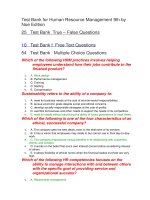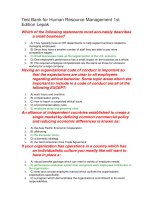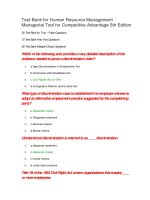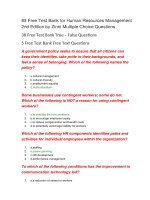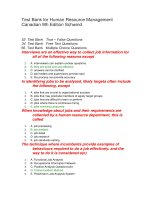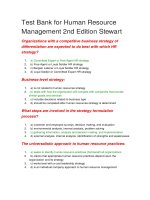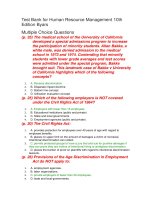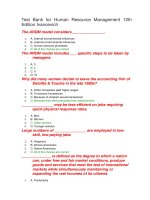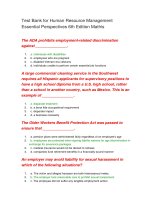Test bank for human resources management in canada canadian edition 12th edition dessler
Bạn đang xem bản rút gọn của tài liệu. Xem và tải ngay bản đầy đủ của tài liệu tại đây (120.62 KB, 20 trang )
Test Bank for Human Resources Management in
Canada Canadian Edition 12th Edition Dessler
Multiple Choice Questions
A company with employees in different provinces/territories
must monitor the legislation in each of those
jurisdictions because
1.
2.
3.
4.
5.
a. it is specified under employment law.
b. legislation changes and it may vary from one jurisdiction to another.
c. it is required under Canada Labour Code.
d. it is required under the Human Rights Act.
e. legislation has commonalities across jurisdictions.
Jim is a new employee. He makes unwelcome sexual
remarks and jokes. His behaviour is offensive and
intimidating to the female employees. Jim's behaviour
is an example of
1.
2.
3.
4.
5.
a. sexual annoyance.
b. permissible behaviour.
c. permissible behaviour as long as it does not violate a policy.
d. sexual harassment.
e. sexual coercion.
Which of the following statements is true about human rights
enforcement procedures?
1.
2.
3.
4.
5.
a. Human rights investigators must obtain a court order before entering an
employer's premises.
b. Most human rights complaints are settled by a Board of Inquiry or Tribunal.
c. A human rights commission can initiate a complaint if it has reasonable grounds
to believe that a party is engaging in a discriminatory practice.
d. Filing a human rights complaint involves significant employee costs.
e. The only human rights cases that can be heard by the Supreme Court of
Canada are those involving federally-regulated employers and employees.
Which of the following statements describe the Charter of
Rights and Freedoms accurately?
1.
2.
3.
4.
5.
a. Legislation cannot be exempted from challenge under the Charter if a legislative
body invokes the "notwithstanding" provision.
b. The Courts of Appeal are the ultimate interpreters of the Charter.
c. The Charter allows laws to infringe on Charter rights if they can be
demonstrably justified as reasonable limits in a free and democratic society.
d. Employment standards legislation supersedes the Charter.
e. It applies to employees in certain provinces only.
For an employment equity program to be successful,
1.
2.
3.
4.
5.
a. an employment equity policy statement should be filed in the company's HR
policies and procedures manual.
b. a senior official should be appointed with the authority to discipline those failing
to comply.
c. an employment equity committee should be given ultimate authority.
d. senior management should be responsible for the implementation process.
e. a written policy, endorsed by senior management and posted throughout the
organization or distributed to every employee, is an essential first step.
The government in each jurisdiction has created special
regulatory bodies to enforce compliance with the law
and aid in its interpretation. Two such bodies are the
1.
2.
3.
4.
5.
a. human rights commission and labour unions.
b. ministry of labour and the HRSDC.
c. ministry of labour and labour unions.
d. employment equity commission and ministry of labour.
e. human rights commission and ministry of labour.
A supervisor informing an employee that refusal to grant
sexual favours will result in a poor performance rating
is an example of
1.
2.
3.
4.
5.
a. executive privilege.
b. sexual coercion.
c. a job related annoyance.
d. sexual annoyance.
e. a BFOR.
Evidence of pervasive patterns of differential treatment
against the employment equity designated groups
includes
1.
2.
3.
4.
5.
a. harassment.
b. systemic discrimination.
c. sexual harassment.
d. discrimination.
e. underemployment.
XYZ is a technology company. In the lobby of its corporate
office, it has a large-screen television that profiles
employees who work at XYZ, as well as other company
information. Employees are asked to supply their
name, business title, and their favourite hobby. The
collection of employee information for this purpose
1.
2.
3.
a. is a violation of PIPEDA and not allowed.
b. can be made a condition of continued employment at XYZ.
c. is allowed as long as the hobby listed doesn’t contain any information that is
defamatory or would otherwise harm the image of the employer.
4. d. is allowed as long as everyone participates without discrimination based on
age, race, or sex.
5. e. is allowed if employees give their consent.
Saleem is a new immigrant with a master's degree in
management. Despite his qualifications, Saleem has
worked as a clerk in the shipping department of a
company for the last year. This is an example of
1.
2.
3.
4.
5.
a. occupational segregation.
b. a BFOR.
c. underemployment.
d. underutilization.
e. indirect discrimination.
ABC company has installed video surveillance equipment
throughout its premises, including in the employee
washrooms, in order to prevent theft of company
equipment and supplies. What would the likely result
be if employees object?
1.
2.
3.
4.
5.
a. Courts would uphold the right of ABC company to install video surveillance
equipment anywhere on its property.
b. Courts would deny the right of ABC company to install video surveillance
equipment since it is an invasion of employee privacy.
c. If the company could demonstrate evidence of widespread employee theft, the
surveillance system would be allowed.
d. Courts would refuse to rule because the case lacks merit.
e. Courts would ask if there is a less invasive way to monitor employees and order
the removal of the video surveillance in the washrooms.
Employers are grappling with the problem of how to balance
employee privacy rights with their need to monitor the
use of technology-related tools because
1.
2.
3.
4.
5.
a. employers are trying to understand how to use technology to increase
employee productivity.
b. employers want to enable employees to respond to work issues when they are
at home and on weekends.
c. employers want to eliminate wasted time and abuse of company resources.
d. employers want employees to voluntarily maintain the organization’s Facebook
page.
e. employers fundamentally do not trust their employees.
Which of the following statements about equal pay for equal
work legislation is true?
1.
2.
3.
4.
5.
a. In the federal jurisdiction, this principle has been incorporated into the
Employment Standards Act since 1971.
b. The principle "equal pay for equal work" makes it illegal to discriminate through
pay on the basis of age.
c. Entitlements are found in the employment/labour standards legislation in every
Canadian jurisdiction.
d. The principle "equal pay for equal work" makes it illegal to pay nurses and fire
fighters differently if their jobs are deemed to be of equal worth to the employer.
e. Every jurisdiction in Canada has legislation incorporating the principle of equal
pay for equal work.
Airlines are legally permitted to
1.
2.
3.
4.
5.
a. indicate a hiring preference for single persons as flight attendants.
b. indicate a hiring preference for single persons as pilots.
c. indicate a hiring preference for women as flight attendants.
d. exclude pregnant women from applying as flight attendants.
e. refuse to hire persons as flight attendants who do not possess minimum
qualifications for the position.
Refusing to hire a man who had been convicted and then
pardoned for a drug-related offence as a counsellor at
a federal correctional centre is an example of
1.
2.
3.
4.
5.
a. intentional direct discrimination.
b. pro-active recruitment.
c. systemic discrimination.
d. protection against negligent hiring.
e. a permissible employer practice under all human rights legislation.
Establishing minimum employee entitlements is most
closely associated with
1.
a. employment equity legislation.
2.
3.
4.
5.
b. the Charter of Rights and Freedoms.
c. pay equity legislation.
d. human rights legislation.
e. employment standards legislation.
The Charter of Rights and Freedoms and the rights it
contains, such as freedom of association, apply to
1.
2.
3.
4.
5.
a. private sector employers only.
b. actions of the federal government only.
c. actions of the federal, provincial, and municipal governments.
d. public and private sector employers.
e. actions of all governments and all employers.
Which of the following statements about the Charter of
Rights and Freedoms is true?
1.
2.
3.
4.
a. The federal government is the final arbiter of the Charter.
b. The overall impact of the Charter on the LR scene has been significant.
c. The Charter provides the right to live and work anywhere in Canada.
d. The Charter provides for minority language education rights and the right to live
and work anywhere in Canada.
5. e. The Charter guarantees the right to strike.
The Charter of Rights and Freedoms
1.
2.
3.
4.
5.
a. is part of the Constitution Act of 1992.
b. applies to all Canadian employees and employers.
c. ensures that no laws infringe on Charter rights.
d. takes precedence over all other laws.
e. is fairly limited in scope.
The Royal Canadian Mounted Police has a requirement that
guards be of the same sex as prisoners being guarded.
This is an example of
1.
2.
3.
4.
5.
a. a violation of a bona fide occupational requirement.
b. reasonable accommodation.
c. intentional and indirect discrimination.
d. a bona fide occupational requirement.
e. systemic discrimination.
A company in the manufacturing sector terminated an
employee because she was pregnant and about to go
on maternity leave. This is a direct violation of the
1.
2.
3.
4.
a. Charter of Rights and Freedoms.
b. Employment Standards Act.
c. human rights legislation of the applicable province.
d. employment equity legislation of the applicable province
5.
e. health and safety legislation.
A local airline refuses to hire as flight attendants any person
who is below 5 feet tall. This is an example of
1.
2.
3.
4.
5.
a. discrimination on the basis of age.
b. a permissible employer practice.
c. a neutral hiring policy.
d. discrimination on the basis of race.
e. discrimination on the basis of race and gender.
The most difficult type of discrimination to detect and
combat is
1.
2.
3.
4.
5.
a. differential treatment.
b. intentional direct discrimination.
c. intentional indirect discrimination.
d. reverse discrimination.
e. systemic discrimination.
Deliberately refusing to hire, train, or promote an individual
on the basis of age is an example of
1.
2.
3.
4.
5.
a. discrimination on the basis of association.
b. intentional/direct discrimination.
c. intentional and indirect discrimination.
d. systemic discrimination.
e. unintentional discrimination.
Which of the following statements is accurate?
1.
2.
a. It is not legally permissible to refuse to hire a blind person to drive a truck.
b. Organizations must be able to show that any physical standards used for
selecting employees for a particular job are truly necessary.
3. c. Accommodating work schedules around religious holidays is generally not
required by human rights legislation.
4. d. Imposing rigid physical standards for certain jobs is not systemic discrimination.
5. e. Accommodating the needs of an employee with depression to the point of
undue hardship is not required in certain Canadian jurisdictions.
A "poisoned" work environment is associated with
1.
2.
3.
4.
5.
a. an occupational health and safety violation.
b. sexual annoyance.
c. a direct link to tangible job benefits.
d. sexual coercion.
e. toxic substances.
Which of the following statements is true regarding people
with disabilities?
1.
a. People with disabilities still fall short of their estimated labour market availability.
2.
b. People with disabilities make up only 2.5% of the federal private sector
workforce.
3. c. The representation of persons with disabilities in the federal public sector
increased to 5.7% in 2004.
4. d. Of all the designated groups, people with disabilities in the private sector have
benefited least from the Employment Equity Act.
5. e. The median employment income of persons with disabilities is 83% of that of
other Canadian workers.
Requesting that an employment agency refer only male
candidates for consideration as management trainees
is an example of
1.
2.
3.
4.
5.
a. discrimination on the basis of gender.
b. discrimination on the basis of association.
c. systemic discrimination.
d. reverse discrimination.
e. a permissible employer practice.
Which of the following statements is true?
1.
2.
3.
4.
5.
a. Human rights legislation prohibits discrimination against all Canadians only in
the area of employment.
b. The human rights tribunal has the power to award damages to a person who
has been discriminated against in hiring and can fine employers who violate human
rights protections, but cannot order an employer to employ someone.
c. It is legally permissible for a bus company to require new drivers to be between
the ages of 24 and 35 for the business purpose that newly hired drivers will get the
least favourable routes and must therefore be young enough to cope with stress.
d. Evidence is readily available to support the position that age is an accurate
indication of a person's ability to perform a particular type of work.
e. The human rights tribunal has the power to order an employer to give a position
to an individual who has been discriminated against and also has the power to
order financial compensation for pain and suffering.
Equal pay for equal work specifies that
1.
2.
a. there can be no pay discrimination on the basis of race, gender, or age.
b. male-dominated and female-dominated jobs of equal value must be paid the
same.
3. c. jobs with similar titles must be paid the same.
4. d. all people doing the same job should receive an identical pay rate.
5. e. an employer cannot pay male and female employees differently if they are
performing substantially the same work.
All jurisdictions in Canada prohibit discrimination on the
grounds of
1.
2.
3.
4.
a. national or ethnic origin, race, and family status.
b. criminal history, sex, and creed or religion.
c. length of employment, race, and marital status.
d. race, sexual orientation, and marital status.
5.
e. sexual orientation, ancestry or place of origin, and family status.
While half of the population in the Greater Toronto Area are
visible minorities, evidence of visible minority
underemployment is the fact that
1.
2.
a. the Toronto mayor has never been a visible minority.
b. in a study of 3257 leaders in the Greater Toronto Area, only 13% were visible
minorities.
3. c. visible minorities are more likely to be hired under employment equity policies
than under “open” recruitment and selection processes.
4. d. many people who are visible minorities own restaurants catering to specific
ethnic tastes.
5. e. crime rates in visible minority neighborhoods is much higher than the overall
crime rate.
Asking young female factory-position applicants to
demonstrate their lifting skills and not asking older
female candidates or any male candidates to do so is
an example of
1.
2.
3.
4.
5.
a. discrimination on the basis of age.
b. discrimination on the basis of age and gender.
c. discrimination on the basis of age and race.
d. a permissible employer practice.
e. unintentional direct discrimination.
If a company classifies male employees as administrators
and female employees doing the same work as clerks
and provides different wage rates based on the
classifications, the company is violating the
1.
2.
3.
4.
5.
a. collective agreement.
b. principle of equal pay for equal work.
c. gender-based discrimination principle.
d. Income Tax Act.
e. none of the above.
Which of the following statements is accurate about
reasonable accommodation?
1.
a. Accommodation short of the point of undue hardship to the employer is
acceptable in certain circumstances.
2. b. An employer is only required to accommodate in the case of discrimination on
the basis of gender.
3. c. Employers are expected to redesign a work station to enable an individual with
a physical disability to do a job.
4. d. Employers are not expected to adjust work schedules to accommodate religious
beliefs.
5.
e. Employers are not expected to adjust employment policies and practices if
discrimination is found.
The Personal Information Protection and Electronic
Documents Act governs
1.
2.
a. the collection, use, and disclosure of personal information across Canada.
b. how governments at all levels may collect and use personal information across
Canada.
3. c. the limits for the collection, use, and disclosure of personal information by
employers.
4. d. the approved uses for data collected using “cookies” on corporate websites.
5. e. the establishment of “do not call” lists in every Canadian jurisdiction.
A justifiable reason for discrimination based on business
necessity is known as
1.
2.
3.
4.
5.
a. reasonable accommodation.
b. permissible discrimination.
c. a business necessity requirement.
d. reverse discrimination.
e. a bona fide occupational requirement.
Employment equity legislation aims to
1.
2.
3.
4.
5.
a. bring the six traditionally disadvantaged groups into the mainstream of
Canada's labour force.
b. remove employment barriers and promote equality for women, visible
minorities, aboriginal people, and persons with disabilities.
c. remedy discrimination on the basis of gender, race, and disability.
d. request employers under provincial jurisdiction to have a better representation
of the designated groups at all levels within the organization.
e. request employers under federal and provincial jurisdiction to have a better
representation of the designated groups at all levels within the organization.
Human rights legislation
1.
2.
3.
4.
5.
a. primarily affects compensation and selection.
b. prohibits intentional discrimination only.
c. affects every employer in Canada.
d. is quite limited in scope.
e. is critically important to HR specialists, but has a relatively insignificant impact
on supervisors and managers throughout the firm.
The groups identified as having been subjected to pervasive
patterns of differential treatment by Canadian
employers, referred to in the federal employment
equity legislation as designated groups, include
1.
2.
a. men.
b. women.
3.
4.
5.
c. homosexuals.
d. clergy.
e. none of the above.
The existence of certain occupations that have traditionally
been performed by males and others that have been
female dominated is known as
1.
2.
3.
4.
5.
a. concentration.
b. occupational segregation.
c. the glass ceiling.
d. underemployment.
e. underutilization.
Examples of systemic discrimination include
1.
2.
3.
4.
5.
a. internal or word-of-mouth hiring policies in work places that have embraced
diversity.
b. job-related employment tests.
c. lack of explicit anti-harassment guidelines.
d. refusing to hire persons convicted of a crime in Canada.
e. refusing to hire persons of Asian origin.
Remedies for human rights code violations do not include
1.
2.
3.
4.
5.
a. a written letter of apology.
b. implementation of an employment equity program.
c. compensation for pain and humiliation.
d. compensation for general damages.
e. ordering an employer to discriminate on a different prohibited ground than the
one complained about.
An employment equity program is designed to
1.
2.
3.
4.
5.
a. increase representation of men on corporate boards.
b. increase occupational segregation.
c. achieve a balanced representation of designated group members.
d. reduce harassment and related complaints.
e. reduce effects of a poisoned environment.
Guidelines for implementing a harassment policy should
include
1.
2.
3.
a. ensuring that a copy of the charge is placed in the file of the alleged harasser.
b. information for victims (for example, identifying and defining harassment).
c. requiring each employee to sign a document indicating that he or she has
received harassment training.
4. d. developing a policy that prohibits harassment on all grounds listed in the
Canadian Human Rights Act.
5. e. all of the above.
Refusing to promote a highly qualified white male into senior
management because his wife has just been
diagnosed with a chronic illness that might interfere
with his willingness to work long hours is an example
of
1.
2.
3.
4.
5.
a. differential treatment.
b. discrimination on the basis of association.
c. discrimination on the basis of disability.
d. systemic discrimination.
e. reverse discrimination.
Steps in the employment equity process typically include
1.
2.
3.
4.
5.
a. obtaining senior-management commitment and support, data collection,
employment systems review training, and follow-up.
b. obtaining senior-management commitment and support, employment systems
review, diversity training, and systems review.
c. obtaining senior-management commitment and support, employment systems
review, implementation, and follow up.
d. obtaining senior-management commitment and support, data collection and
analysis, employment systems review, plan development, implementation, and
monitoring.
e. obtaining senior-management commitment and support, data collection and
analysis, employment systems review, and diversity training.
A national railway has a safety rule that all employees
working in the rail yard must wear hardhats. Several
Sikh employees have refused to follow the rule as their
religion forbids them from removing their turbans,
which is required in order for them to wear the
hardhats. Which of the following statements is true?
1.
2.
3.
4.
5.
a. There is no discrimination.
b. This is systemic discrimination.
c. This is intentional discrimination.
d. This is direct discrimination on the basis of religion.
e. This is systemic discrimination on the basis of religion.
Harassment
1.
a. directed by clients or customers towards an employee is not the employer's
responsibility once it has been reported.
2. b. is prohibited on all prescribed grounds in all jurisdictions and is a violation of
reasonable accommodation.
3. c. includes offensive or humiliating behaviour that is related to a person's sex, as
well as behaviour of a sexual nature.
4. d. on a prohibited ground is not constituted by directing derogatory remarks about
Italians towards an Italian employee.
5.
e. includes unwelcome behaviour that demeans, humiliates, or embarrasses a
person, and that a reasonable person should have known would be unwelcome.
The Supreme Court of Canada has made it clear that
1.
2.
3.
4.
a. it is an employee's responsibility to prevent and report harassment.
b. having a harassment policy is sufficient to prevent harassment claims.
c. supervisors can be liable for failing to take action against harassment.
d. if harassment is occurring, supervisors can ignore it unless an employee reports
it to them directly.
5. e. alleged harassers should be severely punished.
True - False Questions
Some jurisdictions prohibit harassment on all proscribed
grounds, while others only expressly ban sexual
harassment.
1.
2.
True
False
Contract law governs collective agreements and individual
employment contracts.
1.
2.
True
False
Employment equity legislation in Canada requires employers
to meet a quota for members of designated groups.
1.
2.
True
False
Making derogatory comments implying sexual
unattractiveness can constitute sexual harassment if
the person making such comments continues to do so
after being asked to stop.
1.
2.
True
False
Youth aged 17 to 24 are a designated group for Employment
Equity due to the high unemployment rates
experienced by that group.
1.
2.
True
False
Any information collected by an employer beyond name,
title, business address, and telephone number is
considered personal and private and may not be
disclosed without employee consent.
1.
2.
True
False
National or ethnic origin is a protected ground for
discrimination in British Columbia.
1.
2.
True
False
Job evaluation systems that undervalue jobs traditionally
held by women are an example of systemic
discrimination.
1.
2.
True
False
The advancement of women into senior management
positions has been hindered by the existence of a
“glass ceiling”.
1.
2.
True
False
Enforcement of human rights acts is the responsibility of the
RCMP in Canada.
1.
2.
True
False
A company policy that limits employee use of the internet on
company computers is a violation of the privacy rights
of employees.
1.
2.
True
False
Under equal pay for equal work legislation, pay differences
based on a valid merit or seniority system or employee
productivity are permitted.
1.
2.
True
False
Although women make up almost one-half of the Canadian
work force, they are still underrepresented on
executive teams.
1.
2.
True
False
A deliberately structured process is involved when
developing an employment equity program.
1.
2.
True
False
Employers are expected to accommodate to the point of
undue hardship.
1.
2.
True
False
Refusing to hire an individual for a security guard position
on the basis that he or she is considered to be too
large and heavy is an example of a bona fide
occupational requirement.
1.
2.
True
False
Employers may not use video surveillance in the workplace
if a less invasive way of monitoring employees is
reasonable and available.
1.
2.
True
False
Free Text Questions
Identify five prohibited grounds of discrimination and
describe how ONE of the five you identify can be the
source of constructive discrimination.
Answer Given
Any five of the prohibited grounds will do with an example of constructive
discrimination, e.g., a height requirement for police officers.
Sexual harassment has two categories: sexual coercion and
sexual annoyance. Define the two terms and describe
three components of an anti-harassment policy.
Answer Given
Sexual coercion involves offering benefits for sex. Sexual annoyance involves
unwelcome remarks, advances, etc., that create a “poisoned work environment.”
Components for an effective policy can be any of the guidelines from p. 40.
Identify the four designated groups under Employment
Equity legislation. For each of the four designated
groups, describe the way in which the group is underrepresented in the workforce today.
Answer Given
Women, aboriginals, people with disabilities, and visible minorities. Women are
under-represented in leadership positions and remain under-represented in certain
occupations (such as engineering). Aboriginal peoples have an unemployment
rate significantly higher than the general population, and the same is true for
persons with disabilities. Visible minorities are frequently under-employed, with
qualifications that are not recognized in Canada.
Define and give an example of 1) intentional discrimination
and 2) unintentional discrimination—also known as
constructive or systematic discrimination.
Answer Given
Intentional discrimination—deliberately refusing to hire/train/promote someone on
the basis of one of the protected grounds. Unintentional discrimination—policies or
practices that have an adverse impact on specific groups of people for reasons
that are not job related.
An employer is concerned with employee theft in the
workplace and wants to implement a video
surveillance system. What questions should the
employer consider before implementing the system?
In your answer, focus on four aspects of the
implementation of a video surveillance system.
Answer Given
The outline for this answer comes from Figure 2.10 on page 50. The employer
should consider whether there are less intrusive alternatives to a video monitoring
system and put together a business case for its use—then ensure it is only ever
used for that purpose. There should be a policy on video monitoring and limits on
the use and range of the cameras. The public should be informed of the
monitoring, and the recording should be stored securely.
What is a bona fide occupational requirement (BFOR)?
Define the term and give an example of a BFOR for a
truck driver.
Answer Given
A bona fide occupational requirement is a justifiable reason for discrimination
based on business necessity. For a truck driver, a BFOR would be corrected vision
of approximately 20/20.
What steps should an employer use to design an
employment equity program and ensure success?
Answer Given
Employment equity programs are designed to achieve a balanced representation
of designated group members in the organization. It is a major management
exercise because existing employees must be comfortable with other from diverse
backgrounds, cultures, religions, etc. The following are the key steps to follow
when designing a program: 1. Obtaining senior management commitment and
support—a written policy endorsed by senior management should be posted
throughout the organization or distributed to all employees; 2. Data collection and
analysis—this permits the organization to develop an internal work force profile; 3.
Employment systems review—a comprehensive examination of existing policies,
procedures, practices, etc., to determine their impact on designated group
members, so that existing intentional and systemic barriers can be eliminated; 4.
Plan development—setting of goals and timetable; 5. Implementation; 6.
Monitoring, evaluating and revising
